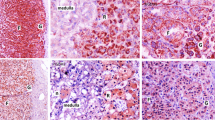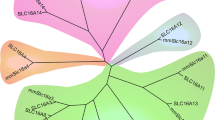Abstract
Mouse U26 has been defined as a 2-aminoadipic 6-semialdehyde dehydrogenase. It was speculated to be a PQQ-dependent AAS dehydrogenase due to the research of demonstrating PQQ as a new B vitamin. We isolated a novel human cDNA from the human fetal brain cDNA library we constructed. Its deduced protein was most related to mouse U26. Thus, we termed it human U26. This putative protein contains an AMP-binding domain, a Phosphopantetheine-binding domain and six PQQ-binding motifs. Human U26 mRNA is ubiquitously expressed in adult tissues and is highly expressed in colon adenocarcinoma (CX-1) and colon adenocarcinoma (GI-112) cell lines. Further study should be made to clarify the precise function of human U26.
Similar content being viewed by others
Abbreviations
- AAS:
-
2-aminoadipic 6-semialdehyde
- PQQ:
-
pyrroloquinoline quinone
- Redox:
-
reduction-oxidation
- CoA:
-
coenzyme A
- PP/4’ PP:
-
phosphopantetheine, or pantetheine 4’ phosphate
- ACP:
-
acyl carrier proteins
- ACS:
-
acetyl-CoA synthetase
- LACS:
-
Long-chain acyl-CoA synthetase
- Fab:
-
fatty acid biosynthesis
Reference
T Kasahara T Kato (2003) Nature 422 832 Occurrence Handle1:CAS:528:DC%2BD3sXjtFCit7o%3D Occurrence Handle12712191
MJ Bibb DH Sherman S Omura DA Hopwood (1994) Gene 142 31–39 Occurrence Handle1:CAS:528:DyaK2cXlt1Knurg%3D Occurrence Handle8181754
DH Mallonee WB White PB Hylemon (1990) J. Bacteriol 172 7011–7019 Occurrence Handle1:CAS:528:DyaK3MXisVWntbk%3D Occurrence Handle2254270
J Schroeder (1989) Nucleic Acids Res 17 460–460 Occurrence Handle1:CAS:528:DyaL1MXptFanug%3D%3D Occurrence Handle2911486
DJ Smith AJ Earl G Turner (1990) EMBO J 9 2743–2750 Occurrence Handle1:CAS:528:DyaK3MXitVagu7s%3D Occurrence Handle2118102
LT Webster (1965) J. Biol. Chem 240 4164–4169 Occurrence Handle1:CAS:528:DyaF2MXkslelsrY%3D Occurrence Handle5845819
H Toh (1991) Protein Seq. Data Anal 4 111–117 Occurrence Handle1:CAS:528:DyaK3MXmsFSqtLk%3D Occurrence Handle1946328
PH Groot HR Scholte WC Hulsmann (1976) Adv. Lipid Res 14 75–126 Occurrence Handle1:CAS:528:DyaE28XktVWmt7c%3D Occurrence Handle3952
A Roujeinikova C Baldock WJ Simon J Gilroy PJ Baker AR Stuitje DW Rice AR Slabas JB Rafferty (2002) Structure (Camb) 10 IssueID6 825–835 Occurrence Handle1:CAS:528:DC%2BD38XksFOisr0%3D
EL Pugh SJ Wakil (1965) J. Biol. Chem 240 4727–4733 Occurrence Handle1:CAS:528:DyaF2MXltVShtb0%3D Occurrence Handle5321311
HC Wong G Liu YM Zhang CO Rock J Zheng (2002) J. Biol. Chem 277 15874–15880 Occurrence Handle1:CAS:528:DC%2BD38Xjs1Wjtr8%3D Occurrence Handle11825906
JA Duine JA Jongejan (1989) Annu. Rev. Biochem 58 403–426 Occurrence Handle1:CAS:528:DyaL1MXkslentro%3D Occurrence Handle2549854
PM Gallop MA Paz R Fluckiger HM Kagan (1989) Trends Biochem Sci 14 IssueID8 343–346 Occurrence Handle1:CAS:528:DyaL1MXls12ksbk%3D Occurrence Handle2572081
J Killgore C Smidt L Duich N Romero-Chapman D Tinker K Reiser M Melko D Hyde RB Rucker (1989) Science 245 850–852 Occurrence Handle1:CAS:528:DyaL1MXlslartrY%3D Occurrence Handle2549636
FM Steinberg ME Gershwin RB Rucker (1994) J. Nutr 124 744–753 Occurrence Handle1:CAS:528:DyaK2cXjt1Wqtbo%3D Occurrence Handle8169668
Goodwin PM & Anthony C (1998) In: Poole RK (Ed) Advances in Microbial Physiology. (Vol. 40, pp 11–80), Academic Press, London, UK.
Z Xia W Dai J Xiong Z Hao VL Davidson S White FS Mathews (1992) J. Biol. Chem 267 22289–22297 Occurrence Handle1:CAS:528:DyaK38XlvVOhtr0%3D Occurrence Handle1331050
M Ghosh C Anthony K Harlos MG Goodwin CCF Blake (1995) Structure 3 177–187 Occurrence Handle1:CAS:528:DyaK2MXltlGmt7w%3D Occurrence Handle7735834
Z Xia W Dai Y Zhang SA White GD Boyd FS Mathews (1996) J. Mol. Biol 259 480–501 Occurrence Handle1:CAS:528:DyaK28XjsFKjt7w%3D Occurrence Handle8676383
Cronan JE & Rock CO (1996) In Neidhardt FC, Curtiss III R, Ingraham JL, Lin ECC, Low KB, Magasanik B, Reznikoff WS, Riley M, Schaechter M, and Umbarger HE (Ed) Escherichia coli and Salmonella: cellular and molecular biology, 2nd ed pp 612–636 American Society for Microbiology, Washington, DC.
Author information
Authors and Affiliations
Corresponding author
Additional information
The nucleotide sequence reported in this paper has been submitted to GenBank under accession number AY314787.
Rights and permissions
About this article
Cite this article
Wang, L., Ji, C., Xu, Y. et al. Cloning and characterization of a novel human homolog* of mouse U26, a putative PQQ-dependent AAS dehydrogenase. Mol Biol Rep 32, 47–53 (2005). https://doi.org/10.1007/s11033-003-2716-4
Received:
Accepted:
Issue Date:
DOI: https://doi.org/10.1007/s11033-003-2716-4




